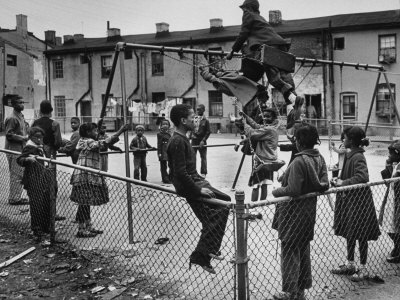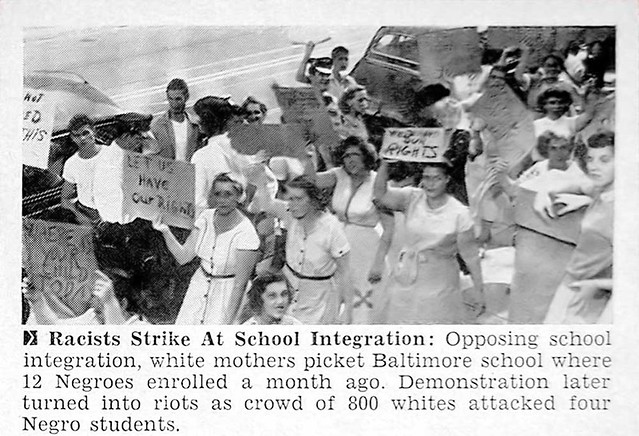
Baltimore City Police officer seperates whites and negro students at Southern High School to prevent fighting.October 1, 1954
From Baltimore City Paper, "A Liberalism Education: Howell Baum's exploration of Baltimore city school desegregation overlooks the local politics in its political posturing," by Edward Ericson Jr. 9 June 2010: In 1954, Baltimore became one of first school districts to voluntarily desegregate, and was the first large American city to do so, earning plaudits for its forward thinking.

Baltimore was the only one of the four early school districts to desegregate using only a "free choice" enrollment model, which simply allowed any student to enroll in any school. Other districts drew boundary lines meant to compel blacks and whites to attend the same schools. University of Maryland Urban Studies and Planning professor Howell Baum spins this remarkable fact into a brilliant and, alas, overwrought, theory in his Brown in Baltimore: "Liberalism," he writes, is what kept Baltimore schools racially segregated.
The story of school segregation--in Baltimore and elsewhere--after the historic 1954 Brown vs. Board of Education cases is now well-known. Rapidly shifting--and informally segregated--housing patterns outran and outflanked school desegregation plans from Baltimore to Boston, from Hartford to Houston. The infamous "massive resistance" threatened by Southern whites turned out to be a camera-ready sideshow to the insidious and much broader patterns of white flight and economic disinvestment that followed.

That thesis--like so much of what passes for scholarship these days--is seductively simple. Baum locates the problem in "liberalism," broadly defined. Liberals of the time believed in free choice and small government (self-described "conservatives" claim that mantel today, but Baum is correct, historically speaking). Because classic liberals believed in free choice and a non-coercive school assignment policy, continuing segregation was all but preordained, Baum argues.


Baum fails to explore how his subjects' actual motives may have diverged from their stated political philosophy. This failure is remarkable given the detailed evidence he marshals.
Much of Brown consists of a blow-by-blow recounting of Baltimore's struggles with desegregation and its failure to embrace racial integration. The detailed account reads in places like meeting minutes, and the long stretches between bouts of analysis and context can leave a reader weary. It's simply not that interesting, 30 years on, to read about the school system's third response to a demand from the Department of Health, Education and Welfare (which split in 1979 into Health and Human Services and the Department of Education) that it voluntarily desegregate city schools.

What is interesting, though, is the behavior of political icons such as Schaefer (he was a sly race-baiter from the start) and--gasp--Barbara Mikulski, who effectively fought desegregation in the city's Southeast neighborhood in the guise of protecting neighborhood cohesiveness from meddling federal bureaucrats.
Much of Brown consists of a blow-by-blow recounting of Baltimore's struggles with desegregation and its failure to embrace racial integration. The detailed account reads in places like meeting minutes, and the long stretches between bouts of analysis and context can leave a reader weary. It's simply not that interesting, 30 years on, to read about the school system's third response to a demand from the Department of Health, Education and Welfare (which split in 1979 into Health and Human Services and the Department of Education) that it voluntarily desegregate city schools.


Much of Brown's narrative rests on the proposition that stemming white flight is the most important aspect in keeping (or making) the city viable. Forced busing will exacerbate white flight, one Johns Hopkins professor warns in the early 1970s as the federal government pressured city officials to act. No, counters another professor, only a specific desegregation policy will assure white families that "school will be integrated wherever they move within the city and will not become overwhelmingly black anywhere."

Baum endorses the latter position, though he never provides any supporting evidence. This argument is questionable on its face, and even more so when you examine the claim that Baltimore schools, under a directed desegregation plan, would "not become overwhelmingly black anywhere" in a city with a public-school enrollment that was already 73 percent black. By any logical assessment, the integration battle was already lost. (By 2004, the 50th anniversary of the Brown decision, it was 89 percent.)

What Baum's Brown is missing is a forthright discussion of the benefit to black students of learning with whites. The study Baum cites, 1966's "Equality of Educational Opportunity Study," published in 1966, paired poor blacks with middle class whites, and did not tease out the effects of race versus the effects of class.

While acknowledging it, Baum does not address in any substantive way the fear of physical harm experienced by students and parents on both sides of the racial divide. How did those fears influence city officials? How do they square with those officials' alleged fealty to liberalism? Baum doesn't say.

Realities bigger than education and segregation outran the law, and Baum could have explored those realities--from the savage disinvestment to the city's increasing reliance on a drug-fueled shadow economy; from its corrupt and dynastic political system to the fraud-fueled real estate market that herded blacks into and whites out of neighborhoods, enriching a corps of well-connected hustlers in the process. By focusing instead on minutia such as meeting minutes from early 1970s school board meetings, hearing transcripts from administrative proceedings--and by presupposing that Baltimore's government operated within a broadly liberal framework (instead of, to cite just one possible counter-narrative, within a framework of institutionalized corruption)--Baum misses much of what made Baltimore the segregated, violent, and poor city it is today. Liberalism certainly played its part in the city's undoing, but piling Baltimore--or even just its dilapidated, predominantly black schools--at the feet of liberalism looks more than uncharitable and less than scholarly.
It looks like marketing. (source: Baltimore City Paper)

What's up, I check your blogs like every week. Your writing style is witty, keep doing what
ReplyDeleteyou're doing!
my website - audiobooki za darmo do pobrania mp3
If there is variety of material selection the teacher must identify that suits every learner's capabilities ,ie slow ,medium and fast . Difference Between Private and Public School Educations In Orange CountyEducation
ReplyDeleteThanks for sharing! Merchant Accounts For Bad Credit - 5 Star Processing
ReplyDeleteMerchant Account For Credit Repair - 5 Star Processing